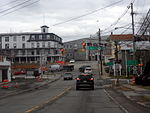Lake Neepaulin
Lakes of Sussex County, New JerseyPapakating Creek watershedReservoirs in New JerseyTributaries of the Wallkill River

Lake Neepaulin is a small man-made freshwater lake located in Wantage Township in Sussex County, New Jersey in the United States. Located in the watershed of Papakating Creek, a tributary of the Wallkill River, the lake was created in the 1950s by damming an unnamed mountain stream as the feature of a private residential development. The stream, now known as Neepaulakating Creek, did not receive a name until 2002.
Excerpt from the Wikipedia article Lake Neepaulin (License: CC BY-SA 3.0, Authors, Images).Lake Neepaulin
North Shore Drive, Wantage
Geographical coordinates (GPS) Address Nearby Places Show on map
Geographical coordinates (GPS)
| Latitude | Longitude |
|---|---|
| N 41.216388888889 ° | E -74.626388888889 ° |
Address
North Shore Drive
North Shore Drive
07461 Wantage
New Jersey, United States
Open on Google Maps





